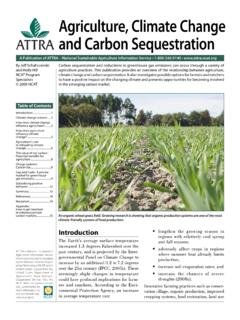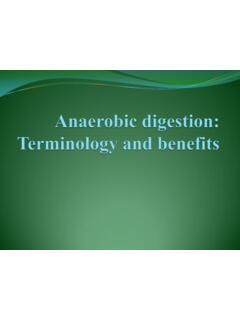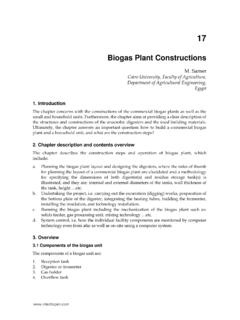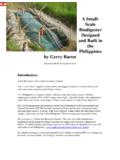Transcription of PROS AND CONS SEAWEED FOR BIOFUEL - Bellona.org
1 SEAWEED (or macroalgae) is a large, diverse group of aquatic plants. Some common species, like sugar kelp, could become a promising source of biofuels , if sustainably produced and used. Compared with, for example soya, which is also used for the production of biofuels , growing SEAWEED is faster, more space-efficient and does not require the use of fresh water or the addition of fertilizer. Furthermore, SEAWEED does not compete for land area. On the contrary, SEAWEED can be grown in exactly the area we have the most of: the sea. biofuels are considered necessary to decarbonise parts of the economy with no alternatives, notably aviation where electrification is not yet available.
2 Europe today meets 90% of its renewable transport target with land-based biofuels , which in many cases are at least as bad as fossil fuels. Meanwhile, climate science shows that fighting climate change will necessarily involve bioenergy, though the sustainable scale remains one of climate science s most unsure areas. While SEAWEED for biofuels will see benefits as well as similar and different challenges to land-based biofuels , we need to consider all alternatives to fossil fuels that reduce difficult emissions. SEAWEED is an essential part of ocean ecosystems. The use of both wild and cultivated SEAWEED should therefore be controlled. Fortunately there is a lot of experience to build on from other ocean industries, such as fish farming, as well as from land, in agriculture and existing biofuels .
3 One such lesson concerns AVAILABILITY. Though SEAWEED is plentiful, it is an under-used source of biomass. The sea covers almost three-quarters of the world and half of the world s biomass grows here. However, we only get 2% of our energy from food that comes directly from the sea. Norway as an example: Salmon farming today covers an approximate 1000km2 of its total 819,620km2 Exclusive Economic Zone. The area within Norway s baseline (grunnlinjen), the most suitable for SEAWEED cultivation, covers 90,000km2 - an area as large as all the agricultural land in Norway, Sweden, Finland and Denmark combined. Of course not all sea area is available or even suitable, but SEAWEED growing is very SCALABLE.
4 SEAWEED can be grown on straight or circular ropes, horizontally and/or vertically, (ideally) down to 10m depth to retain optimal sunlight conditions. There are also integrated solutions to growing SEAWEED that make best possible use of the available space. For example, SEAWEED could be grown in circular systems, like Integrated Multi-Trophic Aquaculture that brings together other sea production, like fish farming and offshore energy. This makes the involved industries both more sustainable and cheaper as, amongst other benefits, it s easier to recycle FACTSHEET pros AND cons SEAWEED FOR BIOFUEL nutrients, SEAWEED grows better when it can use waste nutrients from fish farming, and sharing infrastructure minimises costs.
5 SEAWEED is highly SUITABLE for BIOFUEL . Between 85 and 90% of SEAWEED is water, which means SEAWEED is very suitable for BIOFUEL -making methods like anaerobic digestion to make biogas and fermentation to make ethanol. In addition, many SEAWEED species, like sugar kelp, have high carbohydrate and low lignin content that is perfect for making bioethanol. SEAWEED is one of the most EFFICIENT species, especially in absorbing nutrients like phosphorous and nitrogen. Because SEAWEED grows very fast, it can absorb a lot of CO2, in fact up to 66 tonnes CO2 per hectare, which can help tackle ocean acidification. Fast growth also means CO2 emissions from for instance SEAWEED BIOFUEL are quickly reabsorbed by new growth.
6 In addition, SEAWEED doesn t need fresh water or fertilising. SEAWEED is also highly PRODUCTIVE, growing about 26 tonnes dry weight per hectare, compared to tonnes soya and tonnes corn. A thought experiment: Assuming all nitrogen from farming salmon in Norway could be used for growing SEAWEED , Norway could deliver SEAWEED biomass for the production of 950 million litres ethanol per year (SINTEF, 2009 & Akvaplan Niva, 2016). This is about a quarter of the total fuel consumption of Norwegian road traffic. Delivering this would require less than 1% of the area within Norway s baseline. Challenges with using SEAWEED for BIOFUEL include reducing LOCAL ENVIRONMENTAL IMPACT.
7 Growing SEAWEED could reduce the amount of nutrients in an area, which could affect other sea life higher up the food chain. Several potential impacts need further study, such as the effects of more human activity, risks of cross-breeding wild and cultivated species, diseases and the creation of a non-natural temporary habitat (as a SEAWEED farm would be). Because there are few real-world SEAWEED BIOFUEL projects, measuring LIFE-CYCLE EMISSIONS is difficult. Most emissions don t come from the SEAWEED itselft, but from making nets or doing maintenance and harvesting, which could be improved for example by using electric ships. Cascading use is a central principle of bioenergy, where every part of the plant is prioritised for use in a way that best preserves its core value.
8 Apart from BIOFUEL , SEAWEED can be used for food, animal feed, medicine, paper and fertiliser. It can also replace fossil products besides fuel, including plastics, cosmetics and textiles. Therefore RESOURCE VALUE CHAINS need to be created to safeguard the many uses of SEAWEED . Finally, the BUSINESS CASE for SEAWEED biofuels in not yet developed enough to encourage actors. This, along with better bioenergy sustainability criteria, should be a priority for policy makers.








